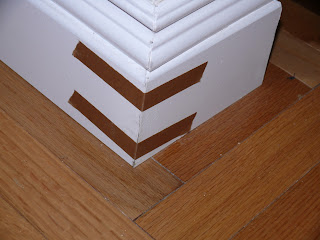 |
| Blue Spruce (USA) Cocobolo Handled Chisels and Mallet (you may recognize this shot from last year's tool calendar) |
The Blue Spruce set is my main bench set that stays in my bench tool slots and I have the full range including the beveled, fishtail and marking tools.
The Harold & Saxon bench chisels are the ones for prolonged dovetailing sessions. made from one of the hardest tool steels in the world, I can usually make an entire project without feeling the need to re-sharpen. The mortise chisels are very substantial and take a serious licking and of course stay razor sharp throughout the abuse.
 |
| BRW Blanks - aren't they precious?? |
Once I cut into the larger piece the figure amazed me and the turning project was on. The challenge for me was getting the handles' shape to match the originals and for them to be close to identical in shape - lots of stopping the lathe and checking with the caliper to make sure everything was in spec. I chose not to shape the flat that the originals had on the handles, as these will be used in a box like the H&S ones above.
I also managed to score a couple of advance copies of the 3/16" and 1/8" sizes to make a complete set in one go. I have been advocating for the 1/8" size for a while; I understand they are VERY hard to make which is why they are not that common. Having used this one for a couple of weeks now, I think Veritas has nailed this and I would strongly recommend this for almost any type of woodworking - one of those tools you don't think you need, but cannot live without once you have had one. I have a 3mm one I bought from a luthier supply house many years ago which is on my wall rack, ready to be used on every project.
Okay, okay, enough pontificating already, here's the money shot:
 |
| Brazilian Rosewood Veritas PMV11 Bench Chisels (L-R 1",3/4",1/2",3/8",1/4',3/16",1/8") |
Thanks to my friends at Lee Valley for helping out with this project; I hope I have done their work justice.
Richard















































